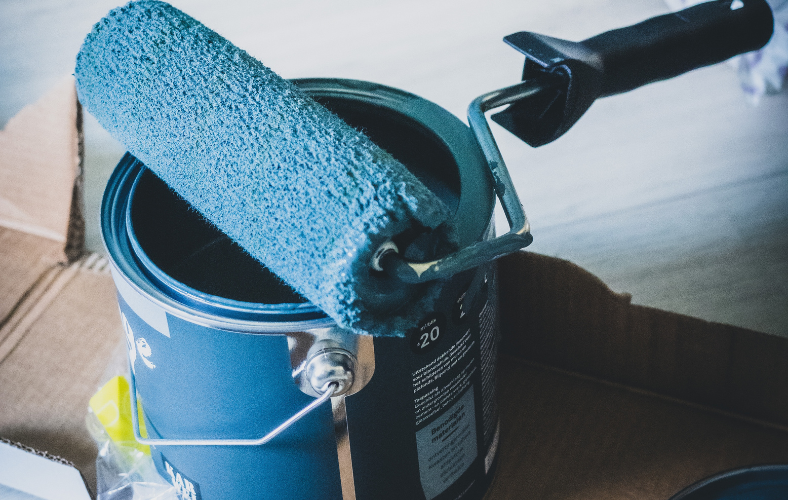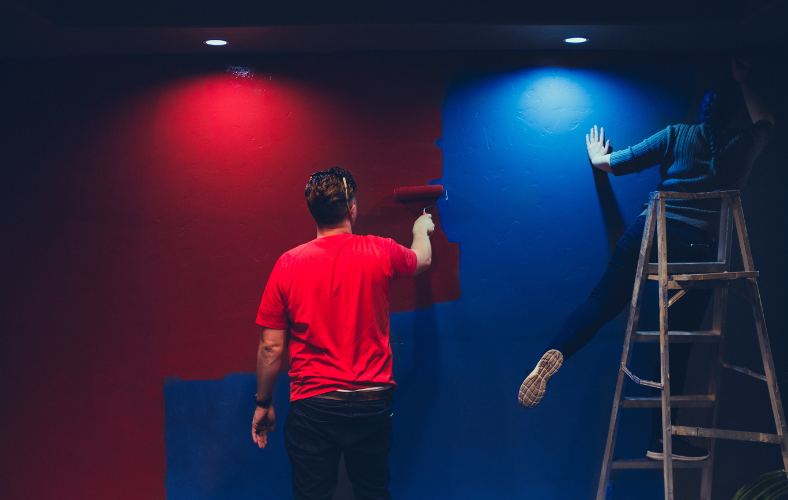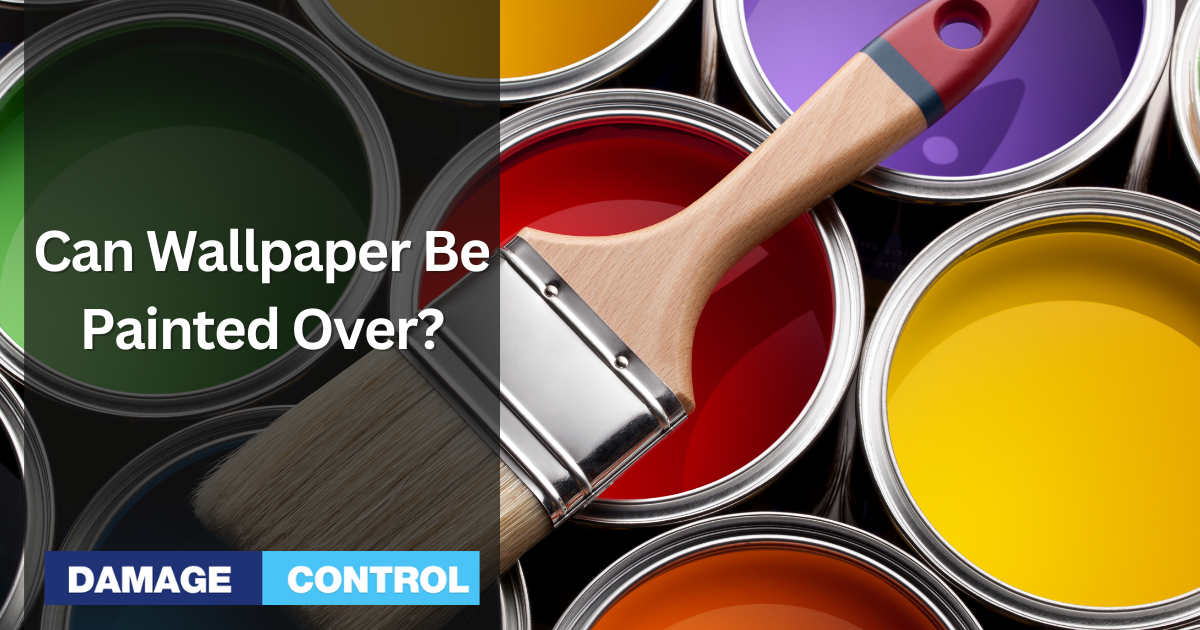When you move into a new home it's normal to deal with the remnants of people who may have lived there before. One of those remnants is often wallpaper. Wallpaper can be frustrating to remove, which leads many to wonder if it can be painted over. It can!
Imagine wallpaper as a blank canvas, waiting for your creative touch. Before jumping into the painting journey, let’s ensure you’re well-equipped.
The Prepping Game

When painting over wallpaper, careful and meticulous preparation differentiates a hasty, lackluster job from a polished, professional finish. Let's expand on the vital steps needed to ensure your painting project shines.
Clean Surface
Before beginning any painting, it's imperative to start with a clean canvas. To do this, gather the necessary materials, including a soft cloth or sponge, a bucket, and mild soap.
Create a soapy mixture in the bucket by combining the mild soap with water. Then, dip your soft cloth or sponge into the soapy solution.
Using gentle, circular motions, scrub the wall's surface. Pay close attention to areas that may have accumulated dirt or grease.
Be careful not to oversaturate the wall, as this can potentially damage wallpaper or the wall itself.
The primary purpose of this step is to eliminate any built-up grime or contaminants from the wall. A clean surface is crucial for ensuring that the paint adheres properly and results in a smooth application.
Repair Damaged Areas
Addressing any damaged or compromised areas on the wall is the next critical step. You will need wallpaper glue or adhesive, a putty knife, and sandpaper for this task.
If you have wallpaper and notice any sections peeling off, apply a thin layer of wallpaper glue or adhesive under the peeling portions. Use a putty knife to gently press down on the glued sections to ensure they adhere firmly.
In the case of tears or holes in the wall, carefully sand the edges of these damaged areas to create a smooth and even surface.
Repairing damaged areas is essential to prevent any imperfections from showing through the paint. It also ensures that your paint won't peel or bubble in these vulnerable spots, resulting in a more polished final appearance.
Prime Time
After cleaning and repairing the surface, it's time to apply a primer, which is a crucial step in the painting process. You'll need high-quality primer, a paint roller, and a paintbrush for this phase.
Begin by “cutting in” the edges of the wall using a paintbrush. This means carefully applying primer to the corners, edges, and areas near the ceiling or trim. Once you've completed this step, use a paint roller to apply the primer to the main wall surface.
Roll the primer in an up-and-down motion to ensure an even coat.
The primary purpose of priming is to provide a stable foundation for your paint. It acts as a bridge between the clean, repaired surface and the paint you'll apply. Proper priming ensures that your paint adheres correctly and lasts longer, resulting in a professional-looking finish.
Why the Emphasis on Prep?
Much like a chef meticulously prepares ingredients before cooking, a painter should never begin without adequately priming the canvas, in this case, the wall. The significance of preparation cannot be overstated for several compelling reasons:
Longevity
When walls are diligently prepped, they serve as a sturdy foundation that preserves the paint's integrity. This ensures that your paint retains its vibrancy and remains free from unsightly chips or peeling over time.
Appearance
Any imperfections on the wall's surface become glaringly obvious once the paint is applied. Conversely, a meticulously prepared and smooth wall serves as the canvas for a flawless finish, where paint adheres uniformly, resulting in a professional and polished appearance.
Cost-Efficiency
Imagine the frustration and expense of having to redo a paint job due to premature peeling or visible imperfections. Proper preparation not only guarantees a better outcome but also saves you money in the long run by preventing the need for costly repaints.
Benefits: Wallpaper Vs. Paint

Both wallpaper and paint have graced our walls for centuries. They each carry a unique set of advantages. When considering a change from wallpaper to paint, it's beneficial to understand the full spectrum of pros and cons.
Painting Perks
One of the advantages of paint is its ability to provide a fresh look. Over time, wallpaper, particularly if it's been on the walls for many years, can fade, yellow, or its patterns might begin to feel outdated. In contrast, applying a new coat of paint can dramatically alter a room's appearance.
This not only revitalizes the space but also allows homeowners to align with current design trends or reflect personal shifts in preference.
Additionally, as design trends change, what once seemed like a great idea can quickly become outdated. For instance, a cherry-red wall that was all the rage five years ago might no longer be in vogue.
Unlike wallpaper, where a change involves a labor-intensive process of removal and re-application, with paint, updating your room's aesthetics is as straightforward as opening a new can of paint. This flexibility ensures that the room can easily keep up with evolving tastes.
Lastly, from a financial perspective, paint often comes out as a more cost-effective choice. While high-end wallpaper can come with a hefty price tag, compounded by the potential cost of professional installation, paint typically presents a more economical option.
Even when accounting for the necessary tools and materials, painting, especially when done independently, tends to be more budget-friendly than purchasing and installing wallpaper.
Wallpaper Wonders
Wallpaper offers several notable wonders that make it an appealing choice for many homeowners. One of its standout features is the intricate designs it offers.
Wallpapers present a vast range of patterns, textures, and finishes that can be difficult to replicate with paint, allowing for a depth and richness in decor that paint might not provide.
Furthermore, when it comes to durability, wallpaper stands out. High-quality wallpapers have the potential to last up to 15 years, serving as a long-term decorative solution. This longevity means they can be particularly resistant to the wear and tear seen in high-traffic areas of a home.
Additionally, wallpaper can be quite forgiving when applied to less-than-perfect surfaces. Unlike paint, which might highlight wall imperfections, wallpaper can mask blemishes, dents, or minor irregularities, making the wall appear smoother and more refined.
Steps to Success
Transitioning from wallpaper to a painted wall requires dedication. Take the process one step at a time.
Step by Step
Transitioning from wallpaper to a painted wall is a task that requires dedication and a methodical approach. Begin by inspecting the wallpaper. Pay close attention to any imperfections and assess whether the wallpaper is secure.
Any loose sections could pose issues during the painting process. To ensure the edges of the wallpaper don't lift after painting, apply a small bead of clear caulk to seal them.
Before applying the paint, it's crucial to use a high-quality primer. This preparation step ensures a smooth and even surface for the paint to adhere to. Once you've applied a consistent layer of primer, it's time to select the right paint.
Latex paint is a great choice because it dries quickly and is less likely to result in wallpaper peeling. Furthermore, you'll need to decide on the desired finish, whether matte, semi-gloss, or gloss.
Lastly, when it comes to painting, it's always preferable to apply two thin coats rather than a single, thicker layer. This technique provides a more uniform finish and ensures better adhesion. Make sure you give adequate drying time between the coats to achieve the best results.
Potential Pitfalls
While the prospect of a fresh paint coat over wallpaper is enticing, it's essential to be aware of potential roadblocks. Recognizing these pitfalls in advance will empower you to tackle them head-on.
A Closer Look at Challenges
Texture Troubles:
-
- What's the Deal?: Even with several layers of paint, some wallpapers, especially those with raised designs or textures, can still be visible.
- Solutions:
- Sanding: Lightly sanding the surface can reduce pronounced textures. However, approach with caution to avoid tearing.
- Thick Primer: Applying a thicker layer of primer can help mask the wallpaper design. Make sure it's evenly spread to avoid a lumpy look.
Bubbling Issues:
-
- What's the Deal?: Bubbles or blisters might appear if the wallpaper wasn't firmly adhered or if the wrong type of primer was used.
- Solutions:
- Wallpaper Adhesive: Before priming, ensure any loose wallpaper is glued back.
- Oil-Based Primer: Consider using an oil-based primer. It's less likely to cause a reaction that results in bubbles.
Peeling Problems:
-
- What's the Deal?: If the surface wasn't cleaned or primed properly, your fresh paint might not stick around for long, leading to unsightly peels.
- Solutions:
- Rigorous Cleaning: Dust, grime, and residue can be sneaky. Ensure every inch is clean.
- Adhesive Primer: Some primers are specially designed to adhere better over tricky surfaces like wallpaper.
Tackling the Hurdles
Preparedness is half the victory. By understanding these potential pitfalls, you're already a step ahead in your painting journey. And remember, patience is key. Each challenge has a solution, and with a bit of effort and foresight, your freshly painted wall can indeed be a sight to behold.
Conclusion: To Paint or Not to Paint?
Can you paint over wallpaper? Absolutely. But is it always the best option? That depends.
If you're seeking a change without the fuss of removing wallpaper, painting is your ally. Yet, every wall tells a story. Yours may require a bit more prep or perhaps a different approach.
Whatever path you choose, armed with this knowledge, you're set to create a masterpiece. After all, home is where our story begins.

